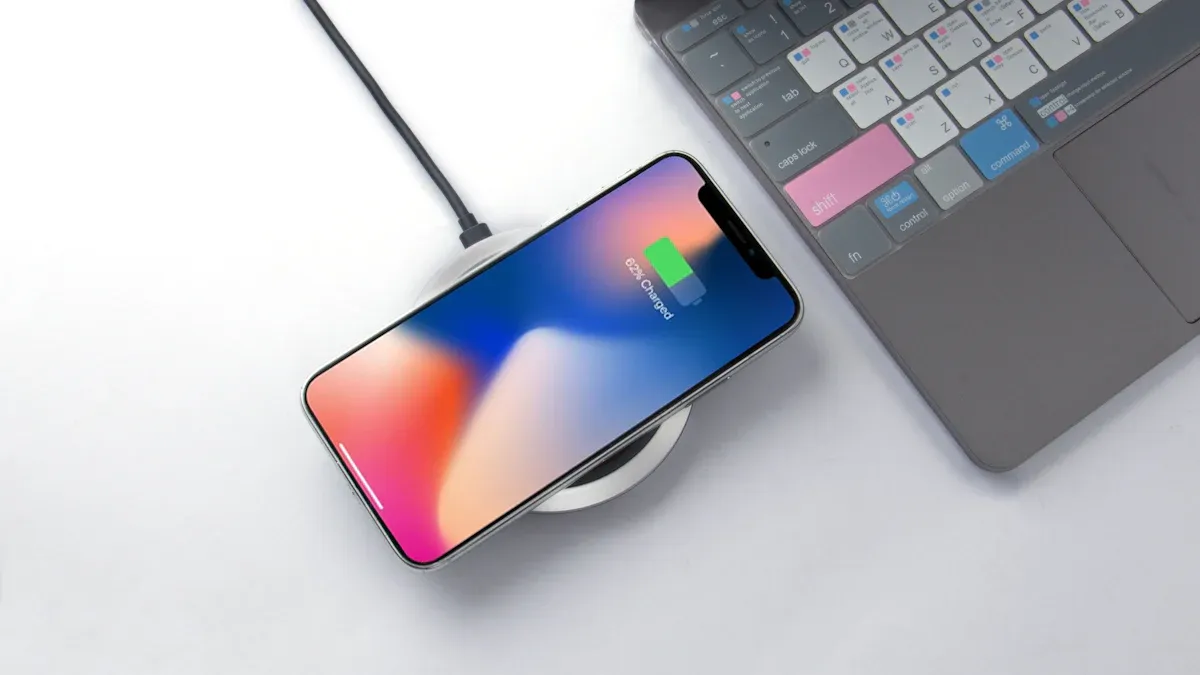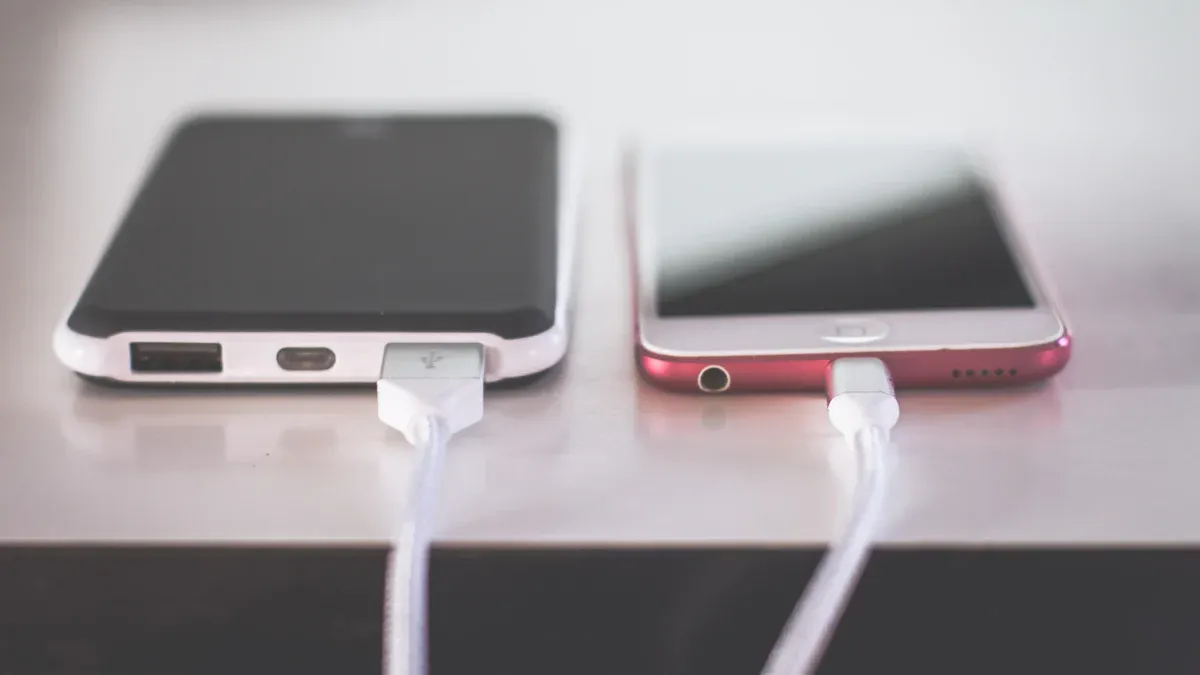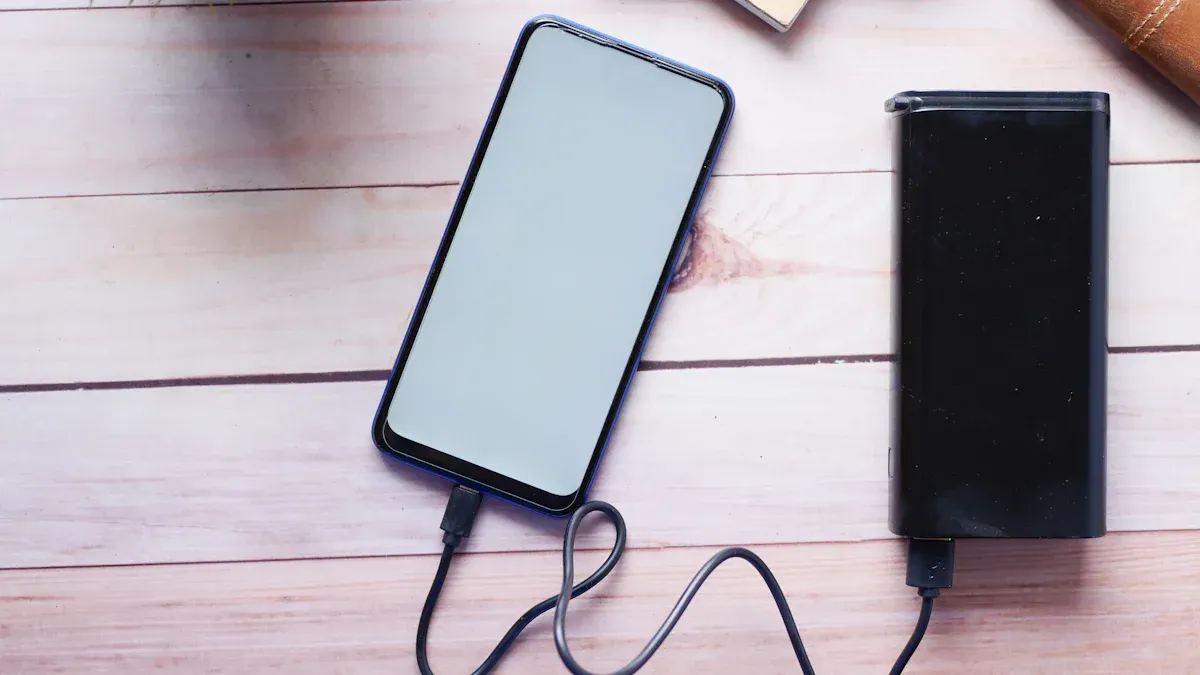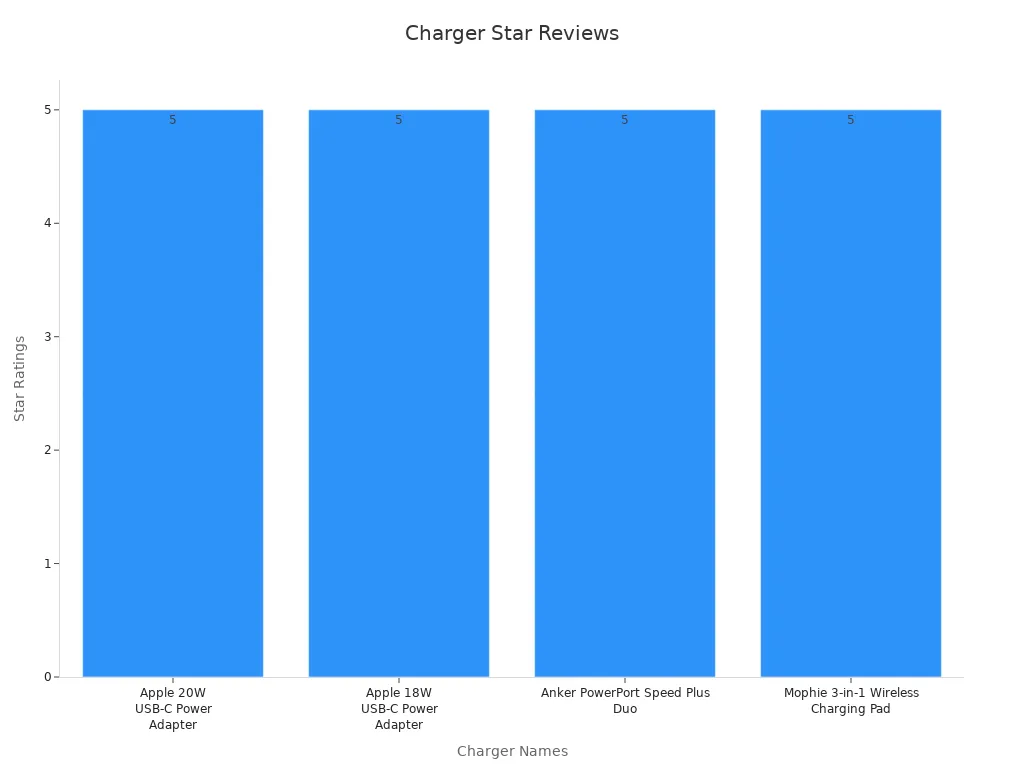Switching to USB-C fast chargers for your iPhone can completely transform your charging experience. Why wait hours for your battery to fill up when USB-C can fast charge your device up to 50% in just 30 minutes? Compare that to the old 5W charger, which only gets you to 20% in the same amount of time. Plus, USB-C chargers deliver up to 100 watts of power, blowing Lightning cables out of the water in terms of speed. They’re not just faster—they’re smarter too. With advanced power delivery, USB-C chargers protect your iPhone’s battery health while keeping overheating at bay.
The Benefits of USB-C Fast Chargers for iPhones
Faster Charging with USB-C Power Delivery
If you’re tired of waiting for your iPhone to charge, USB-C power delivery is here to save the day. This technology can charge your iPhone up to 50% in just 30 minutes. That’s a game-changer compared to older chargers. USB-C PD delivers up to 18 watts of power, which is significantly faster than the 12 watts offered by Power IQ. It’s especially effective when your battery is low, as fast charging works best from 0-50%. After that, the charging speed slows down to protect your battery.
What makes USB-C PD even better is its ability to communicate with your iPhone. It adjusts the power output based on what your device needs, ensuring efficient and safe charging. You get the perfect balance of speed and safety every time you plug in.
Efficiency Gains Over Lightning Cables
USB-C fast chargers don’t just charge faster—they’re also more efficient. Unlike Lightning cables, which max out at 27 watts, USB-C can handle much higher power levels. With USB PD 3.0, you can get up to 100 watts of power, and USB PD 3.1 takes it even further with up to 240 watts. That’s a huge leap in performance!
Here’s a quick comparison to show how USB-C stacks up against Lightning cables:
| Cable Type | Max Charging Power | Estimated Time to 50% |
|---|---|---|
| USB-C PD 3.0 | Up to 100W | ~15–30 minutes |
| USB-C PD 3.1 | Up to 240W | ~10–20 minutes |
| Lightning (iPhone) | Up to 27W | ~30–40 minutes |
USB-C chargers are also smarter. They use USB power delivery to communicate with your iPhone and charger, deciding how much power to draw. This makes them more efficient and safer than Lightning cables, which have limited power output.
iPhone Models That Support Fast Charging
Not all iPhones support fast charging, but most recent models do. If you have an iPhone 8 or newer, you’re in luck! These models are compatible with USB-C fast charging technology. Whether you’re using an iPhone 11, iPhone 13, or the latest iPhone 15, you can enjoy the benefits of faster and more efficient charging.
Switching to USB-C fast chargers is a no-brainer if you want to save time and keep your iPhone powered up. With the right charger, you’ll never have to worry about running out of battery when you need it most.
Ensuring Safety with USB-C Fast Chargers
When it comes to fast charging your iPhone, safety should always be a top priority. USB-C fast chargers are designed with advanced features to protect your device, but there are still steps you can take to ensure a safe and efficient charging experience.
Protecting Battery Health During Fast Charging
Fast charging doesn’t have to harm your iPhone’s battery if you follow a few simple tips. First, avoid charging your phone to 100% whenever possible. Charging to full capacity can cause voltage stress, which may shorten your battery’s lifespan. Instead, aim to keep your battery level between 30% and 80%. This range is ideal for maintaining long-term battery health.
Temperature also plays a big role in battery performance. Lithium-ion batteries, like the one in your iPhone, work best in temperatures between 77°F and 104°F (25°C to 40°C). Extreme heat or cold can speed up battery degradation. For example, cold temperatures can lead to lithium plating, while heat increases internal resistance. To avoid these issues, try not to use fast chargers in very hot or cold environments.
You can also use apps to monitor your battery’s temperature. These tools can alert you if your phone gets too hot or cold during charging. With proper thermal management, fast charging technology won’t harm your battery.
Preventing Overheating and Overcharging
Overheating and overcharging are common concerns when it comes to fast charging. Thankfully, modern iPhones and USB-C fast chargers come with built-in protections to address these issues. For instance, iPhones use a battery management system that monitors the charging process. This system slows down the charging speed once your battery reaches 80%, reducing the risk of overheating.
The “Optimize Battery Charging” feature in iOS 13 and later takes this a step further. It keeps your battery charge between 80% and 90% until you need a full charge. This feature not only prevents overheating but also helps extend your battery’s lifespan.
Overcharging is another worry, but it’s largely a thing of the past. Modern chargers and smartphones are designed to stop charging once the battery is full. Unless there’s a circuit problem, your iPhone won’t overcharge.
Safe Usage Tips for USB-C iPhone Chargers
Using your USB-C fast charger correctly can make all the difference. Here are some tips to keep your iPhone safe:
- Choose certified chargers: Always opt for chargers with certifications like MFi (Made for iPhone). Over 60% of consumers prefer certified products, and 73% are willing to pay more for them. These chargers are tested for safety and reliability.
- Avoid counterfeit products: Fake chargers may lack essential safety features, putting your iPhone at risk. Stick to trusted brands to ensure quality.
- Unplug when not in use: Leaving your charger plugged in can waste energy and increase wear on the device.
- Keep your charger clean: Dust and debris can interfere with the connection, leading to overheating. Wipe your charger and cable regularly to keep them in good condition.
By following these tips, you can enjoy the benefits of USB-C fast charging without compromising your iPhone’s safety.
Choosing the Right USB-C Fast Charger for Your iPhone
Understanding Wattage and USB-C Power Delivery
When choosing a USB-C fast charger, wattage is one of the most important factors to consider. For iPhone fast charging, you’ll need a charger that supports at least 20 watts. If you’re using newer models like the iPhone 12 or later, a 30-watt USB-C power adapter is ideal for even faster charging. Higher wattages, such as 60W or 100W, can also charge other devices like MacBooks or iPads.
USB-C power delivery (USB-C PD) technology ensures your iPhone gets the right amount of power. It adjusts the voltage and current to match your device’s needs, making charging both fast and safe. Here’s a quick look at how USB-C PD profiles work:
| Profile | Voltage | Current | Power | Supported devices |
|---|---|---|---|---|
| 1 | 5 V | 2 A | 10 W | Smartphones, small accessories |
| 2 | 12 V | 1.5 A | 18 W | Smartphones, tablets |
| 3 | 12 V | 3 A | 36 W | Notebooks, displays |
| 4 | 20 V | 3 A | 60 W | Larger notebooks, hubs |
| 5 | 20 V | 5 A | 100 W | Workstations, external GPUs |
With USB-C PD, you can trust that your iPhone will charge efficiently without overheating or overloading.
Ensuring Compatibility with iPhone Models
Not all iPhones support fast charging, so it’s essential to check compatibility before buying a charger. If you own an iPhone 8 or later, you’re in luck—these models work seamlessly with USB-C fast chargers. For the best results, pair your iPhone with a USB-C to Lightning cable or a USB-C to USB-C cable, depending on your device.
Here’s a quick compatibility chart to help you out:
| iPhone Model | Fast Charging Capability | Required Adapter |
|---|---|---|
| iPhone 8 or later | Up to 50% in 30 minutes | 18W or greater |
| iPhone 15 | Up to 15W with MagSafe | 20W or greater |
If you’re using an older iPhone, you may need to stick with standard charging methods. But for newer models, upgrading to a USB-C fast charger is a game-changer.
Recommended Brands for iPhone Chargers
Choosing the best iPhone chargers means sticking to trusted brands. Certified chargers ensure safety and reliability, so you don’t have to worry about damaging your device. Here are some top-rated options:
| Charger Name | Average Review | Reasons to Buy | Reasons to Avoid |
|---|---|---|---|
| Apple 20W USB-C Power Adapter | ☆☆☆☆☆ | Fast and reliable | Expensive |
| Anker PowerPort III Nano | ☆☆☆☆☆ | Compact and affordable | Slightly lower wattage |
| Belkin BoostCharge 30W | ☆☆☆☆☆ | Great for iPhones and other devices | Bulky design |
| Mophie 3-in-1 Charging Pad | ☆☆☆☆☆ | Charges multiple devices at once | Higher price compared to others |
Always look for certifications like MFi (Made for iPhone) to ensure your charger meets Apple’s safety standards. Avoid counterfeit products, as they can overheat or damage your iPhone. Stick with reputable brands like Apple, Anker, and Belkin for peace of mind.
By understanding wattage, compatibility, and trusted brands, you can find the perfect USB-C fast charger for your iPhone.
Identifying and Avoiding Counterfeit Chargers
Counterfeit USB-C chargers might look like a great deal, but they can put your iPhone and even your safety at risk. These fake chargers often lack the safety features found in genuine products, making them prone to overheating, electrical shocks, or even fires. So, how can you spot and avoid these dangerous knockoffs?
First, always buy from trusted retailers or directly from the manufacturer. Apple’s investigation revealed that 90% of chargers sold as genuine on Amazon were actually counterfeit. These fake products often fail to meet safety standards, increasing the risk of overheating or electrical shock. If a deal seems too good to be true, it probably is.
Pay attention to the packaging and build quality. Genuine USB-C chargers have clear labeling, sturdy materials, and proper certifications like MFi (Made for iPhone). Counterfeit chargers, on the other hand, may have misspelled words, flimsy construction, or missing certification marks. If you notice any of these red flags, steer clear.
Here’s a quick look at some findings about counterfeit chargers and their risks:
| Source | Findings |
|---|---|
| Electrical Safety First | 98% of counterfeit iPhone chargers tested could cause electric shocks or fires. |
| Apple’s Investigation | 90% of chargers sold as genuine on Amazon were counterfeit. |
| U.S. Consumer Product Safety Commission | Costco recalled 567,000 portable chargers due to overheating and fire risks. |
Lastly, don’t forget to check the price. Genuine USB-C fast chargers and power adapters are rarely sold at rock-bottom prices. If you see a charger priced significantly lower than usual, it’s likely a fake. Protect your iPhone by investing in a certified charger. It’s worth the peace of mind.
By staying vigilant and following these tips, you can avoid counterfeit chargers and keep your iPhone safe while enjoying the benefits of USB-C PD technology.
USB-C fast chargers are a game-changer for your iPhone. They deliver faster charging speeds and greater efficiency compared to older options. By choosing a certified power adapter and following safe charging practices, you can protect your iPhone’s battery health. USB-C PD technology ensures your device gets the right amount of power every time. Whether you’re charging smartphones or other devices, USB-C offers unmatched convenience. Upgrade to a USB-C charger today and enjoy a seamless charging experience while keeping your iPhone safe and ready to go.
FAQ
What is the best wattage for fast charging an iPhone?
For fast charging, use a USB-C charger with at least 20 watts. If you have a newer iPhone model, a 30-watt charger works even better. Higher wattages are safe but won’t necessarily charge your iPhone faster.
Can fast charging damage my iPhone’s battery?
No, fast charging won’t harm your battery if you use certified chargers. iPhones have built-in battery management systems that regulate power and prevent overcharging. Stick to trusted brands for peace of mind.
Do all iPhones support USB-C fast charging?
No, only iPhone 8 and newer models support USB-C fast charging. Older models don’t have this feature. Check your iPhone’s compatibility before buying a USB-C charger.
How can I tell if a USB-C charger is counterfeit?
Look for certifications like MFi (Made for iPhone) and buy from trusted retailers. Counterfeit chargers often have poor build quality, misspelled labels, or suspiciously low prices. Avoid these to protect your device.
Is it safe to leave my iPhone charging overnight?
Yes, it’s safe. Modern iPhones stop charging once the battery is full. The “Optimize Battery Charging” feature also helps maintain battery health by pausing charging at 80% until needed.




